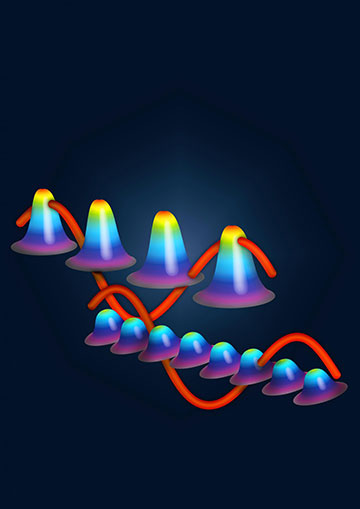
Illustration: researchers were able to shape the electric field of an attosecond pulse. [Image: Jürgen Oschwald and Carlo Callegari]
The advent of femtosecond lasers has revolutionized chemistry by giving scientists a window into how molecular systems transform from reactants into products. The next frontier in the field involves tracking the motion of valence and core electrons on their intrinsic timescales with attosecond pulses.
An international team of researchers has achieved a milestone in attosecond physics by controlling and shaping the waveform of an attosecond pulse generated by a free-electron laser (Nature, doi: 10.1038/s41586-020-2005-6). This type of amplitude and phase manipulation opens up countless experimental possibilities for the investigation of ultrafast electronic processes in atoms, molecules, nanostructures and solids.
A free-electron-laser approach
Previously, attosecond pulses could only be created by the nonlinear process of high-order harmonic generation (HHG). Intense femtosecond laser pulses in the visible and near-infrared spectral range are focused inside a dense atomic gas jet, which then emits the odd harmonics of the driving radiation. The coherent superposition of these harmonics results in a train of attosecond pulses.
Several methods for shaping these attosecond waveforms were attempted, but all failed to control the relative phase between the harmonics. The authors of the current study decided to take a completely different approach by using extreme-ultraviolet pulses from a free-electron laser at the FERMI facility in Trieste, Italy to generate attosecond pulses.
“We are aiming to extend the attosecond toolbox, which was developed over the last 20 years by the HHG community, to a free-electron-laser-based attosecond source,” said corresponding author Giuseppe Sansone of the University of Freiburg, Germany. “We see remarkable advantages for these sources, including the high energy per pulse and the superior degree of control on the characteristics of the attosecond pulses such as pulse duration and phase.”
Overlapping harmonics
Earlier experiments at FERMI successfully created femtosecond pulses with the facility’s free-electron laser, but they lacked coherent control. In 2016, the team demonstrated the coherence of two harmonics using the undulators available at FERMI. The new challenge for Sansone and his colleagues would be to generate four phase-coherent harmonics that temporally overlap to form attosecond pulses.
“We realized that we could generate different harmonics using different undulators, and moreover, we could also control the relative phase between the harmonics. This is not possible with HHG-based attosecond pulses,” said Sansone. “Therefore, the generation of attosecond pulses at free-electron lasers is inherently connected to the capability of controlling their shape.”
The free-electron laser not only produced high-intensity attosecond pulses, but the researchers could independently control and shape the amplitudes and phases of the pulses. Lastly, they characterized the relative phases between the harmonics with a technique called RABITT (reconstruction of attosecond beating by interference of two-photon transition), modified to accommodate the limitations of a free-electron laser.
Future attosecond science at FERMI
In the future, Sansone and his colleagues want to take full advantage of the unique capabilities of the attosecond pulses generated at FERMI for time-resolved investigations of atoms and molecules. In particular, he has his sights set on exploiting the high energy per pulse, on the order of microjoules, which may allow for nonlinear time-resolved attosecond experiments.
